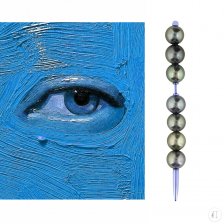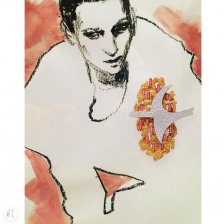BETWEEN THE SEEN AND THE UNSEEN: THE DREAMSCAPES OF TINUS VERMEERSCH
It is I who am sitting there in that undefined landscape where everything has disappeared or is yet to happen. Once inside, I embrace the solitude and I know what I have to do there.
Tinus Vermeersch
Tinus Vermeersch, a Belgian artist who moves fluidly between the surreal and the everyday, offers an invitation to embrace the unknown.
It is a journey inward: an excavation of the subconscious, where shifting forms and disquieting landscapes conjure a world in flux. His "tegumen" motifs, organic and hair-like, have become a signature, symbolizing protection, transformation, and the passage of time. The word tegumen in Latin means "protection" or "cover," further deepening the layers of meaning in these recurring forms, pulsing with change, fragility, and a meditative impermanence.
What makes Tinus so captivating is his refusal to be confined by a single medium, whether oil, ink, ceramics, or sculpture. In a quiet intimacy in his creations, a sensation lingers that is born in the deep recesses of the mind, reflecting a personal and universal vision of the world.
In this interview, the artist reflects on the origins of his dreamlike figures and abstract landscapes, offering insight into the subconscious forces that shape his work. His thoughts on color, material, and form reveal a creator in constant conversation with his own creations, guided by instinct rather than intention. And as you read, you will follow him into the very act of creation itself: slow, deliberate, and deeply connected to the fabric of reality.
For those who seek to understand the rich layers of meaning behind these enigmatic works, this conversation is just the beginning. Explore the quiet, powerful world of Tinus Vermeersch, where nothing is as it seems, and everything is about to unfold.
It is difficult to say why I am so attracted to hair-like structures. It must have something to do with their mobility and the fact that they cover and conceal from view. They protect and soften what is hard.
Tinus Vermeersch
The JI: Hair often carries cultural and personal significance. In your “tegumen” forms, hair-like textures dominate. What does hair represent to you, and how does it relate to themes of identity, protection, or transformation in your work?
Tinus Vermeersch: It is difficult to say why I am so attracted to hair-like structures. It must have something to do with their mobility and the fact that they cover and conceal from view. They protect and soften what is hard. In my work, they are unstable structures that are in constant transformation, mobile organic waves and twists that can represent vegetation, water, wind and fire, depending on whether they are depicted hanging, lying or rising. It is probably this versatility and changeability of meaning, and the simple fact that I like drawing fluid lines that makes me return to them time and again.
As a child, I once had a very high fever for a few days, and I saw curls and swirls filling the room. At night, in my dreams, I saw slow, floating, shape-shifting boulders.
Tinus Vermeersch
The JI: Your artworks evoke dreamlike landscapes and figures. To what extent do dreams or subconscious thoughts influence your creative process? Are the “tegumen” manifestations of inner psychological states?
Tinus: There are many things that influence my creative process. Dreams and subconscious thoughts are one of them. It happens that I see a very clear shape or intense image in my dream. If that image also imposes itself on me when I wake up, I try to capture it in a drawing or painting during the day. Of course, it always looks much better in my dream, and I usually fail to visualise it, but that attempt feels like a new beginning of something. Suddenly, I see other possibilities within my work and a renewed urge to create images arises. But that doesn't happen very often.
(As a child, I once had a very high fever for a few days, and I saw curls and swirls filling the room. At night, in my dreams, I saw slow, floating, shape-shifting boulders.)
Subconscious thoughts will undoubtedly influence my creative process, but because I am not aware of them, it is difficult to say to what extent and how. I think you can say that the "tegumen" are a product of that. It is a form that feels essential to me, simultaneously very individual and universal. I recognize it as an old acquaintance.
Vermilion red is my favourite; painting with it is almost like a religious ritual.
Tinus Vermeersch
The JI: Your use of color, especially vibrant reds and earthy tones, adds so much emotional depth to your pieces. How do you approach color selection, and what emotional or symbolic roles do these colors play in your artistic narratives?
Tinus: My choice to work with certain colours depends largely on the type of paint I use. In tempera, I tend to use earth tones as my dominant colour palette because those pigments really come into their own in that medium. In oil paint, I lean more towards bold pigments because they really come into their own in that medium. My choice is driven by the fact that I find them so beautiful.
Experiencing beauty can put me in an emotional state, so in that sense my choice is emotionally driven. I almost never mix colours on my palette or on the panel, in order to preserve their individuality. However, I do use glazes to mix them optically so that they do not lose their power.
Vermilion red is my favourite; painting with it is almost like a religious ritual. But I do not associate colour with any particular symbolism or meaning, although I love their receptivity as carriers of symbolism. I merely insinuate that it can stand for something, such as colour being used to reinforce group identity or being linked to transitional customs.
For me, red, for example, does not have to represent anything; I mainly want to show it at its best, which is to be fully sublime red.
I do not start a work with the intention of investigating something.
Tinus Vermeersch
The JI: Your works often depict solitary figures or forms in sparse landscapes. What themes of isolation, introspection, or intimacy are you exploring through these compositions?
Tinus: I do not start a work with the intention of investigating something. Sometimes there is a vague idea or a sketch of what it might look like. Things constantly appear and disappear during the process; nothing is fixed, not even the theme. Content emerges as I paint and only becomes clearer as forms become more distinct. This often leads to landscapes in which little happens, with figures that do not seek contact with the viewer. It is I who am sitting there in that undefined landscape where everything has disappeared or is yet to happen. Once inside, I embrace the solitude and I know what I have to do there.
Depending on the technique used, the hair-like structures will change in feel and thus, throughout the whole of the paintings, sculptures and drawings, may also change in meaning.
Tinus Vermeersch
The JI: From ceramics to paintings, your choice of medium varies. How does the material you choose influence the message or feeling of a piece, particularly concerning the tactile nature of hair-like textures?
Tinus: The choice of material influences the focus I place on depicting the same forms and structures. In a sculpture, I will place more emphasis on the ornamental nature of the hair-like elements, as a tangible physical form, referring to classical architectural elements. In paint, the same form will be much more suggestive and will be used more as a carrier of colour. In my pen drawings, the focus is more on the structure and material itself. So, depending on the technique used, the hair-like structures will change in feel and thus, throughout the whole of the paintings, sculptures and drawings, may also change in meaning.
All the intrinsic content of a work is contained in the way in which matter is shaped or applied to a medium without serving anything outside itself. First and foremost, it must be visually convincing, without interpretation. It needs to be nothing more than being there.
Tinus Vermeersch
The JI: Being part of a family with a rich artistic heritage, how has your lineage influenced your voice? Do you see your work as a continuation or departure from your family’s artistic traditions?
Tinus: Experiencing reality differently or more intensely and wanting to express that visually was a matter of course in our home.
When you look at our work, you wouldn't immediately say that we are family; we are very different in that respect. What we have in common is the importance we attach to how a work is made and the time and care we devote to its execution. I think this stems from the conviction that all the intrinsic content of a work is contained in the way in which matter is shaped or applied to a medium without serving anything outside itself. First and foremost, it must be visually convincing, without interpretation. It needs to be nothing more than being there.
In that sense, you could see what I do as a continuation. Being part of such an artistic legacy could be both stimulating and intimidating.
I never felt the need to oppose or break with it. In my own work, I can see influences from my grandfather and father, but I have always strived to find my own personal language, using the artistic values and visions I inherited as a solid foundation.














